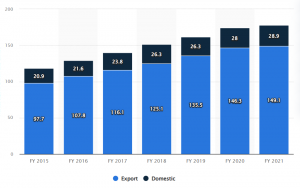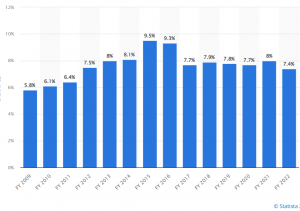
From the time we wake up in the morning to the time we go to sleep and wake up again, technology surrounds us. We are so used to filling every day, hour, and minute of our lives with everything tech that we often take for granted. It would be hard to imagine a world without search engines, internet banking, UPI apps, social media, and online learning tools. Try to imagine the situation if there was no Aarogya Setu app during pandemic.
While it may be daunting to imagine our world without them, some of these applications would not have been possible if there was no NASSCOM, or the Indian IT Maverick as we would like to call it. NASSCOM birthed Indian IT, nurtured it, and molded it to become the scaffolding for all technologies that we see around us today.
READ I Cyber security: India must update digital infrastructure, legal framework
NASSCOM: Values and contributions
Harish Mehta, the first elected chairperson of NASSCOM, chronicles its journey in his newly published book, The Maverick Effect. NASSCOM empowered the IT services industry to achieve a CAGR of 30% over the last 30 years. This exemplary growth is higher than most industries in the country. Indian IT is among the very few industries to have negligible NPAs. NASSCOM’s founding values continue to guide it till today. Some of them are:
• Being transparent while having an independent and neutral thinking
• Building a trusting environment for all stakeholders to thrive
• Collaborate and complete with a single voice, keeping India first
• Robust conflict resolution, and
• Identifying opportunities early on, differentiating it from noise.
Without NASSCOM, the IT services industry would not have taken off. Archaic regulations would have continued to cripple growth and competing countries would have raced right ahead. Bringing 80% of the industry on one platform enabled business continuity planning at an industry level.
READ I Corporate governance: India must embrace tech, global best practices
Reclaiming India’s glory
Historically one of the two richest countries along with China, India lost its economic power to colonial plunder. Old India derived its wealth from trade, artistry, and culture. Today, India has transitioned to a smart nation. It has leveraged innovation, technology, and intellectual capital to become an empowered, sustainable, and a digitalised country. NASSCOM has been at the forefront of this transition.
NASSCOM gave India purpose and direction. Technology alone would not have made the difference. What NASSCOM did – got technology, governments, corporates, and citizens all together. Going forward, we hope it brings together cross-domain, multidisciplinary think tanks to drive evidence-based research, keeping in focus the needs of a billion Indians.
Market size of the IT-BPM industry in India

Share of IT-BPM industry in India’s Gross Domestic Product

While enjoying its demographic dividend, India has a set of unique challenges. Its societal intangibles, cultural boundaries, and hierarchy of needs are its own. The advent of technology is rapidly upending the status quo. While the world automates making human jobs redundant, NASSCOM would like for India to leverage technology to drive upskilling and productivity.
In a world constantly at loggerheads and wars, India’s edge comes from its innate soft power and natural gifts of mathematics, spirituality, and humanity. We are confident that if the collective knowledge and insights of Indians are applied, we can lift millions out of poverty.
Talent engine for the world
Information technology is an industry so universal, yet not apparent. Urban infrastructure development, education, women empowerment, and significant contributions to the exchequer have been key impacts of the IT industry. Having an industry revenue of $227 billion in 2022, the government has now set a goal of $500 billion for the Indian IT sector. NASSCOM plans to achieve this challenging feat through skill development, innovation, and digital transformation.
NASSCOM’s initiatives like the ‘Future Skills Prime’ aim to bridge the gap between education and employability. Reaching every student in India, it intends to establish India as the talent engine of the world. CXOs of some of the world’s leading tech companies come from the Indian IT fraternity. In an effort to incubate and fund 10,000 tech start-ups in 10 years, NASSCOM launched the 10,000 Start-Ups Initiative back in 2010. NASSCOM in its next innings could support innovation in emerging fields such as AI, IoT, cloud, and cybersecurity. Having a potential to create a million technopreneurs with a focus on under-represented groups such as women, rural innovators, and social enterprises.
Creating world’s foremost DPGs
The story of Indian IT started off as an outsourcing unit and problem solver of the world. Today, we are creating the world’s foremost stack of Digital Public Goods (DPGs), popularly referred to as the India Stack. India Stack is defined as “the moniker for a set of open APIs and DPGs that aim to unlock the economic primitives of identity, data, and payments for the population at scale.” It is:
• A vision for the world/ for India
• A vehicle for social and financial inclusion
• National plumbing for the Internet age
• A collection of open APIs empowering people and business, and
• Inspired by the principles of open-source software and interoperability.
Launched as UIDAI in 2009, it has evolved into one of the most advanced government-linked direct benefit transfer networks in the world. Some of these numbers highlight its success:
• 67 billion – Total number of digital identity verifications
• Rs 5.47 trillion – Total value of monthly real-time mobile payments, and
• 2.8 billion – Volume of monthly real-time mobile payments.
Leveraging the inherent capabilities of the India Stack, India is balancing atmanirbharta (self-reliance) with paraspar nirbharta (mutual dependence). The role of the government is slowly moving from rule framing to exception monitoring. It is simultaneously working on strengthening existing tech infra and bolstering fundamental research in new-age tech.
Protecting the next billion Internet users
The ubiquitous presence of the Internet and affordable phones is fueling the next billion users to join the internet. Asia, and India in particular, is a leading contributor to this billion. Millions of users join the internet for the first time every week. These users significantly influence the internet and strategy of tech companies.
Wearing the hat of a digital anthropologist tells us their societal preferences, extent of literacy, hierarchy of needs, and ultimately their perception of privacy. While technologists are racing to gather this data, curate solutions, and monopolise, we see NASSCOM evolving. We see it moving from just an association of IT service providers to being the foremost advocates of citizen data privacy rights.
We see NASSCOM supporting a common voice even among competitors for the greater good of technology. In its latest avatar, NASSCOM could plan to roll out multiple wings to shore up Web 3.0, robotics, CRISPR, cybersecurity, and fintech.
NASSCOM could support the government to undertake pre-emptive policymaking, enhanced IP protection, and data-protection laws to create a level-playing field for all businesses. It suggests technology policymaking to go beyond specialised domains, and be informed by ethical considerations.
NASSCOM with its unparalleled contribution to IT services has delivered a robust template for other industry bodies to get inspired from. This is India’s century – we urge all industry bodies to go the NASSCOM-way, forge cross-sector collaborations and bring home what’s truly ours.
(Suyash S. Agrawal is Co-Founder and Managing Director of You Commit, We Implement. The views expressed by the authors are their own.)
Shailesh Haribhakti is a Chartered and Cost Accountant, an internal auditor and a certified financial planner. He is a board chairman, audit committee chair and independent director at some of the country's most preeminent organisations. He is a thought leader on the Indian economy and public policy.

